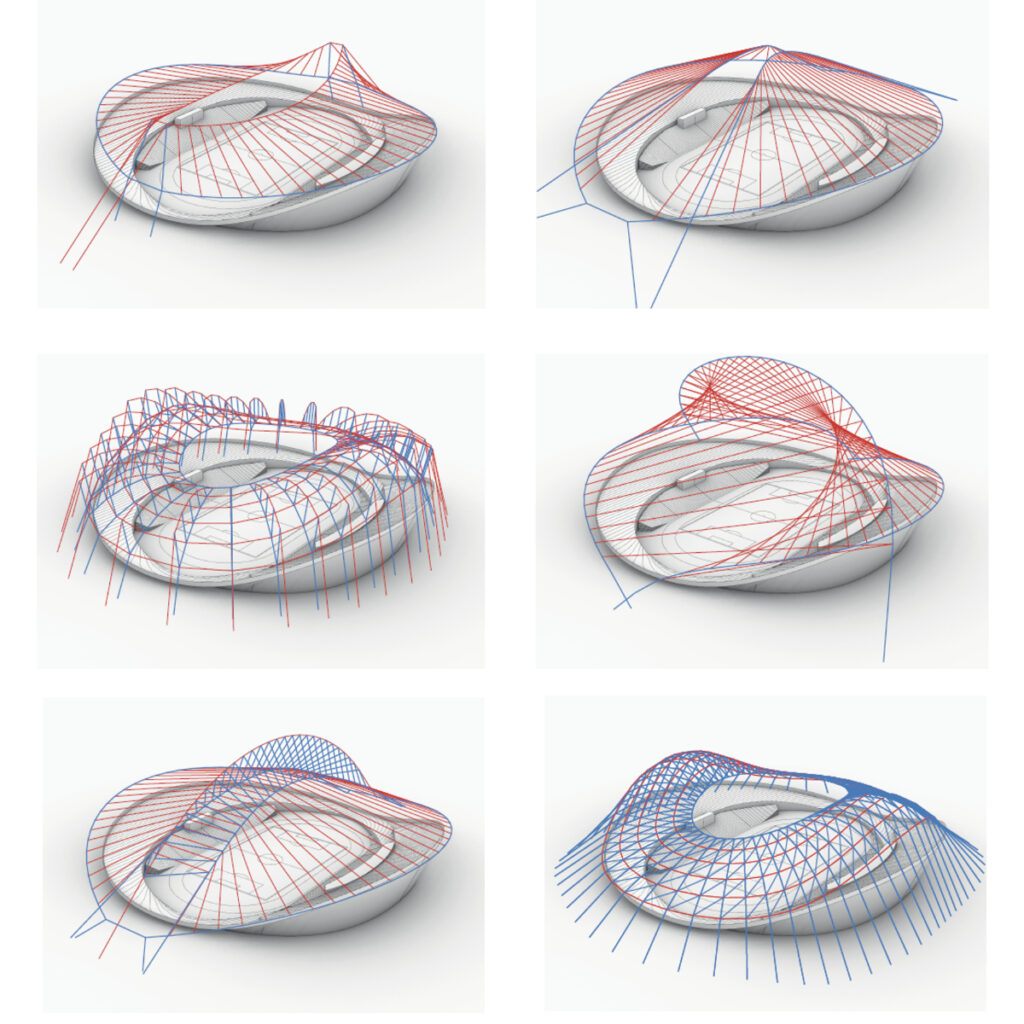
Description:
Required Skills: Proficiency in the use of McNeel Rhinoceros and Grasshopper.
Required Software: McNeel Rhinoceros 7 for Windows or Mac.
Required Hardware: Laptop or any other computational hardware viable for running McNeel Rhinoceros 7
Maximum number of participating students: 100
The workshop will introduce the participants to novel methods for the design of 3D structures in static equilibrium. The workshop will be specifically focused on the Vector-based Graphic Static (VGS) and the Combinatorial Equilibrium Modelling (CEM) tools developed as plug-ins for the parametric software environment McNeel Rhinoceros and Grasshopper. The workshop will explore the design opportunities offered by combining both the VGS and CEM tools. The aim is to leverage the potentials of equilibrium-based modelling for the conceptual design of structures. Vector-based Graphic Static (VGS) is a direct extension of traditional 2D graphic statics to the third dimension. VGS introduced a generalized procedure for the construction of a 3D vector-based force diagram (representing the forces acting in a structure) for any given 3D form diagram of a spatial network in static equilibrium. By establishing an interdependency between form and force diagrams, VGS allows users to transform one of the diagrams and evaluate directly the resulting transformation of the other diagram. This property allows for a quick and interactive exploration of possible equilibrium solutions in the early design phase. The Combinatorial Equilibrium Modelling (CEM) is a powerful geometry-based form-finding approach that is grounded on vector-based graphic statics and graph theory. The CEM is particularly tailored for the design and transformation of mixed tension-compression structures, based on user-defined topological (i.e. connectivity of the structural elements) and metric (i.e. distribution of internal forces within the structure) inputs and given geometric constraints. In particular, the proposed equilibrium-based structural design process includes the following steps:
- The CEM tool is used to find the form of a mixed tension-compression structure in static equilibrium for given topological and metric inputs (computational form-finding).
- The form diagram (F) of the structure is generated using the VGS Form-Diagram Assembler.
- The force diagram (F*) of the structure is computed using the VGS Force-Diagram Assembler.
- By taking advantage of the interdependence between form and force diagrams, the VGS Transformation Tool enables users to explore equilibrium solutions by manipulating form and forces at the same time.
Schedule:
timezone: (GMT +1:00) Brussels, Copenhagen, Madrid, Paris| Start time | End time | Description |
|---|---|---|
| 2022-06-27 - 14:00 | 2022-06-27 - 15:00 | Introduction of tutors and participants. • Introduction of the content of the workshop. |
| 2022-06-28 - 09:00 | 2022-06-28 - 13:00 | General introduction on the theoretical background and the basic knowledge of vector-based Graphic Statics. • Brief explanation of the Combinatorial Equilibrium Modelling (CEM) and its applications. Demos and tutorials on the CEM tool within Rhino and Grasshopper. |
| 2022-06-28 - 14:00 | 2022-06-28 - 17:00 | Brief explanation of the Vector-based Graphic Static (VGS) and its applications. Demos and tutorials on the VGS tool within Rhino and Grasshopper. • Brief overview of the workflow of integrating the CEM with VGS. • Introduction to the design exercise. Individual development of the structural concept by each participant. |
| 2022-06-29 - 09:00 | 2022-06-29 - 13:00 | Implementation of the concept using VGS/CEM with supervision by the tutors. • Set up of the final poster with the workshop outcome. |
Instructors:
 |
Pierluigi D'Acunto | Pierluigi D'Acunto received his Diploma in Building Engineering and Architecture with Honours from the University of Pisa (Italy) in 2007 and a Master of Architecture with Distinction from the Architectural Association School of Architecture in London (UK) in 2012. In 2018, he obtained his PhD degree with Distinction at the Chair of Structural Design at ETH Zurich. From 2018 to 2021, Pierluigi was Lecturer and Postdoctoral Researcher at ETH Zurich, and the director of the architectural office xmade GmbH at Basel. Pierluigi is currently Assistant Professor of Structural Design at the Technical University of Munich. His research is primarily focused on exploring the convergence of architecture and engineering through graphic statics and computational design. |
 |
Jean-Philippe Jasienski | Jean-Philippe Jasienski graduated in Architectural Engineering from the UCLouvain (Belgium) in 2012 and studied at the Universidad del Bío-Bío in Concepción (Chile) during his master. He currently works part-time at the LOCI faculty from UCLouvain as a research and teaching assistant and guest lecturer. He is developing a PhD in the Structure & Technologies research unit since 2012 with Prof. D. Zastavni (UCL), L. Ney (Ney & Partners) and C. Fivet (EPFL). His research examines the properties of vector-based 3-D graphic statics for both structural design and analysis. Besides, he is a partner at MATADOR, a Brussels-based architecture office focusing mainly on public buildings. |
 |
Yuchi Shen | Yuchi Shen is now a Postdoctoral Researcher at Southeast University the school of Architecture. He was a visiting PhD student in ETH Zurich during 2019 to 2020 in the teaching chair of Prof. Joseph Schwartz. In 2021, he achieved his PhD degree under the supervision of Prof. Jianguo Wang and extended his research field from the bioinspired structural computational form finding to a boarder range on low carbon architectural structure design by Graphic Statics. He is now working on developing the VGS tool cooperating with and guided by Prof. Pierluigi et.al.. |
Disclaimer:
All workshops will accept 100 applications MAX.



